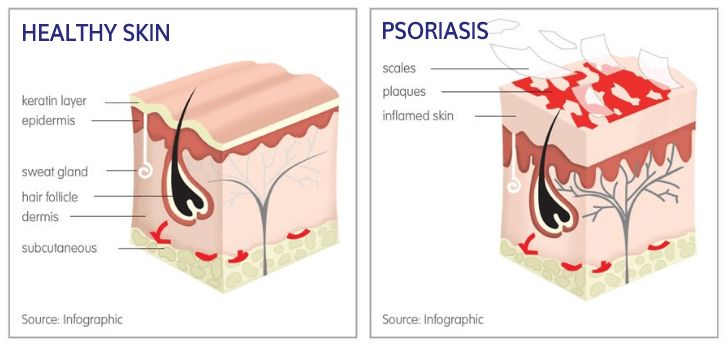Plaque Psoriasis
WHAT IS PLAQUE PSORIASIS?
Plaque psoriasis is a long-term (chronic) disease of the skin. It is not known exactly how many people in New Zealand are affected by plaque psoriasis but based on the prevalence in other countries it is estimated to affect around one in 30 New Zealanders.1,2 The disease is more likely to develop in individuals with a family history however can occur in anyone. It most often appears in teenagers or in adults under the age of 30.
Psoriasis occurs when skin cells are replaced more frequently than usual. The process isn’t fully understood but it is thought that a problem in the immune system triggers the body to start over- producing some of its own skin cells. In people with plaque psoriasis, certain immune cells are over activated and produce higher than normal levels of signals and proteins. One such immune protein is called tumor necrosis factor (TNF). This protein can cause skin cells to grow too quickly. It is not known what causes this problem with the immune system but genetics and environmental factors may be involved.
The severity of psoriasis can differ greatly from person to person. In some people, it may be very mild, while in others the condition may have a major impact on their quality of life. The symptoms of psoriasis may also come and go over time. Approximately 20–25% of people with plaque psoriasis will go on to develop psoriatic arthritis – a long-term inflammatory condition that causes a person’s joints to become inflamed (swollen), painful and stiff.3
- BPAC NZ. Chronic plaque psoriasis: an overview of treatment in primary care, January 2017. Accessed from: https://bpac.org.nz/2017/psoriasis-1.aspx (Last accessed September 2023)
- Jones C, et al. Psoriasis. Accessed from: http://www.dermnetnz.org/topics/psoriasis/ (last accessed August 2023).
- Alinaghi F, Calov M, Kirstensen LE, et al. Prevalence of psoriatic arthritis in patients with psoriasis: A systematic review and meta-analysis of observational and clinical studies. J Am Acad Dermatol 2019;80(1):251–265.
SYMPTOMS
While psoriasis can appear on any part of the body, it most often shows up on elbows, knees, and the lower back. More severe cases can cover large areas of the body. The plaques can be itchy, sore, or both, or they may be red but not itchy or sore. Psoriasis often goes through cycles, or ‘flare-ups’, causing problems for a few weeks or months before easing or stopping. Sometimes joints may become stiff, painful and/or swollen (psoriatic arthritis), and this can be disabling.
Skin cells usually mature over 30 days, however, in psoriasis, skin cells are produced every 5-7 days. This causes a build-up of cells, or cell clumping, and creates raised, red patches on the skin often with silvery scale ‘plaques’ (thick areas). The scaly skin flakes off.
Factors that cause these ‘flare-ups’ can include:
- Emotional stress
- Injury to the skin
- Some types of infections (e.g. sore throats)
- Reactions to certain medications
SKIN AFFECTED BY PSORIASIS IS USUALLY RED AND FLAKY

Types of plaque psoriasis
There are three main types of psoriasis, which are each unique in terms of prevalence, age and symptoms. Learning more about the type of psoriasis you have will help determine the best treatment.
Large plaque psoriasis can cover a wide area, like the scalp, torso and arms and legs. It often runs in families and it usually appears before the age of 40. This is the most common type of psoriasis, accounting for 80% of cases.1
Guttate psoriasis causes lots of small (about the size of a tear drop), similarly sized, scaly pink patches to appear mainly on the torso. Often the person affected has had a respiratory infection, often a strep throat, a few days or weeks before the appearance of the rash. This type of psoriasis often disappears after a few weeks; however, in some cases, a person with Guttate psoriasis may go on to develop plaque psoriasis. This is the second most common type of psoriasis. It accounts for about 2% of psoriasis cases, and it usually starts in childhood or young adulthood.1
Scalp psoriasis can sometimes be very mild, with slight, fine scaling or it can be severe with thick plaques covering the entire scalp. This form of psoriasis doesn’t tend to run in families. It is more likely to start in people over 40.
- Langley RGB et al. Ann Rheum Dis 2005; 64(Suppl II):ii18-ii23


HOW IS IT TREATED?
Because there is no cure for plaque psoriasis yet, treatment is aimed at reducing the symptoms and clearing the plaques back to normal skin.
MEDICATIONS
Common types of medications for psoriasis include:
Topical (medications that are applied to the skin):
For mild plaque psoriasis, which covers only a small area of the body, topical lotions and creams can work well. These include topical steroids, coal tar treatment or calcipotriol (vitamin D).
Systemic (medications that work throughout the body):
When the plaques are too big or too extensive to be managed with topical treatments, systemic agents (which work throughout the body) can be used. These can improve or even clear up symptoms. You will need to undertake screening tests before starting on systemic agents. These tests make sure the medication is safe for your particular case. Types of systemic medication used in the treatment of plaque psoriasis include immunosuppressants or retinoids. Immunosuppressants target the ‘over-active defence cells’ of the immune system. They include: methotrexate, cyclosporine and mycophenolate. Retinoids, such as acitretin, are a form of vitamin A and regulate the rate of skin cell turnover.
Biologic:
Biologic medications are used when other medications have been tried but severe symptoms are still present. Medications like ENBREL® are made from human proteins that restrain another protein already in your body called tumour necrosis factor (TNF), which is a naturally occurring chemical messenger in your bloodstream. Too much TNF plays a part in the over-production of skin cells that leads to plaque psoriasis. ENBREL® works by helping to block the effects of too much TNF.
SUPPORT OPTIONS
Plaque psoriasis can be treated and controlled. It is important that you talk to your doctor or visit a dermatologist to decide what treatment is right for you. Starting treatment as soon as possible may help to improve your future with plaque psoriasis.
For more information on the treatment of psoriasis, visit the website of New Zealand dermatologists www.dermnetnz.org
Arthritis New Zealand has information on psoriatic arthritis, which can appear at the same time as plaque psoriasis:
Arthritis New Zealand
PO Box 10-020
Wellington
Freephone 0800 663 463
www.arthritis.org.nz
If you need further assistance with Enbrel® administration, or have questions about your condition or treatment, contact your healthcare professional, or call 0800 Enbrel® (0800 362 735).
Enbrel® is a registered trademark - © Pfizer 2023.
Other Ways to Control Your Symptoms:
Phototherapy
The affected area is treated under ultraviolet light B (UVB) or ultraviolet light A (UVA). This can be to your whole body or targeted to specific areas such as the hands or scalp.
Lifestyle
- Maintain a balanced diet
- Maintain a healthy weight
- Moderate alcohol consumption; your doctor or dermatologist can tell you how much is safe for you.
- Give up smoking. Smokers are more likely to develop psoriasis.
For more information and support on how to quit smoking, phone Quitline 0800 778 778 or visit www.quit.org.nz

